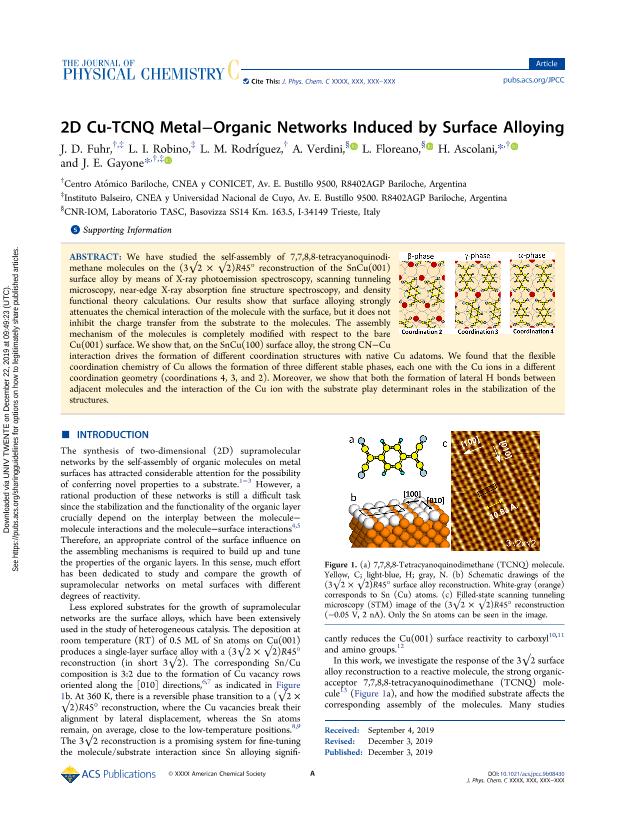Artículo
2D Cu-TCNQ Metal-Organic Networks Induced by Surface Alloying
Fuhr, Javier Daniel ; Robino, L.I.; Rodríguez, L.M.; Verdini, A.; Floreano, L.; Ascolani, Hugo del Lujan
; Robino, L.I.; Rodríguez, L.M.; Verdini, A.; Floreano, L.; Ascolani, Hugo del Lujan ; Gayone, Julio Esteban
; Gayone, Julio Esteban
 ; Robino, L.I.; Rodríguez, L.M.; Verdini, A.; Floreano, L.; Ascolani, Hugo del Lujan
; Robino, L.I.; Rodríguez, L.M.; Verdini, A.; Floreano, L.; Ascolani, Hugo del Lujan ; Gayone, Julio Esteban
; Gayone, Julio Esteban
Fecha de publicación:
12/2019
Editorial:
American Chemical Society
Revista:
Journal of Physical Chemistry C
ISSN:
1932-7447
Idioma:
Inglés
Tipo de recurso:
Artículo publicado
Clasificación temática:
Resumen
We have studied the self-assembly of 7,7,8,8-tetracyanoquinodimethane molecules on the (3√2 × √2)R45° reconstruction of the SnCu(001) surface alloy by means of X-ray photoemission spectroscopy, scanning tunneling microscopy, near-edge X-ray absorption fine structure spectroscopy, and density functional theory calculations. Our results show that surface alloying strongly attenuates the chemical interaction of the molecule with the surface, but it does not inhibit the charge transfer from the substrate to the molecules. The assembly mechanism of the molecules is completely modified with respect to the bare Cu(001) surface. We show that, on the SnCu(100) surface alloy, the strong CN-Cu interaction drives the formation of different coordination structures with native Cu adatoms. We found that the flexible coordination chemistry of Cu allows the formation of three different stable phases, each one with the Cu ions in a different coordination geometry (coordinations 4, 3, and 2). Moreover, we show that both the formation of lateral H bonds between adjacent molecules and the interaction of the Cu ion with the substrate play determinant roles in the stabilization of the structures.
Palabras clave:
SURFACES
,
METALLORGANICS
,
ALLOYS
,
MONOLAYERS
Archivos asociados
Licencia
Identificadores
Colecciones
Articulos (UE-INN - NODO BARILOCHE)
Articulos de UNIDAD EJECUTORA INSTITUTO DE NANOCIENCIA Y NANOTECNOLOGIA - NODO BARILOCHE
Articulos de UNIDAD EJECUTORA INSTITUTO DE NANOCIENCIA Y NANOTECNOLOGIA - NODO BARILOCHE
Citación
Fuhr, Javier Daniel; Robino, L.I.; Rodríguez, L.M.; Verdini, A.; Floreano, L.; et al.; 2D Cu-TCNQ Metal-Organic Networks Induced by Surface Alloying; American Chemical Society; Journal of Physical Chemistry C; 124; 1; 12-2019; 416-424
Compartir
Altmétricas



